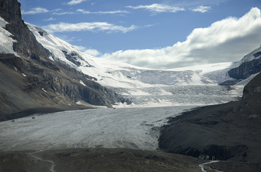Module 7 Summary
| Site: | MoodleHUB.ca 🍁 |
| Course: | Math 20-3 SS |
| Book: | Module 7 Summary |
| Printed by: | Guest user |
| Date: | Tuesday, 2 December 2025, 7:05 AM |
Description
Created by IMSreader
1. Module 7 Summary
Module 7 Summary

iStockphoto/Thinkstock
Did you know that more than three-quarters of Earth’s fresh water is stored as ice? It is estimated that 29 million km3 of ice covers various parts of Earth. The primary ice sheets are in Antarctica and Greenland. The Columbia Icefield between Alberta and British Columbia is the largest complex of glaciers south of the Arctic. Nature’s transportation system for this fresh water is the three major rivers that have their origin in the Columbia area: the North Saskatchewan, the Athabasca, and the Columbia.
Because of climate change, these glaciers have been retreating. For example, the Athabasca Glacier of the Columbia Icefield in the photograph has lost half its volume and has retreated more than 1.5 km in the last 125 years. Without snow replenishing the volume of ice in these glaciers, the drinking water of millions of people is at risk.
In this module you explored the related concepts of volume and capacity. You reviewed the SI units, imperial units, and United States Customary Units used to measure volume and capacity.
Your study involved the application of formulas, in a variety of practical contexts, for the volume of pyramids, cubes, prisms, cones, cylinders, and spheres. These applications included problems from the trades and daily living. You also applied these formulas to determine the capacity of containers.
As well, you explored how changing an object’s linear dimensions changes the object’s surface volume.
You applied many of these skills in the Module 6/7 Project: Clear the Roads! This project is an examination of snow removal.